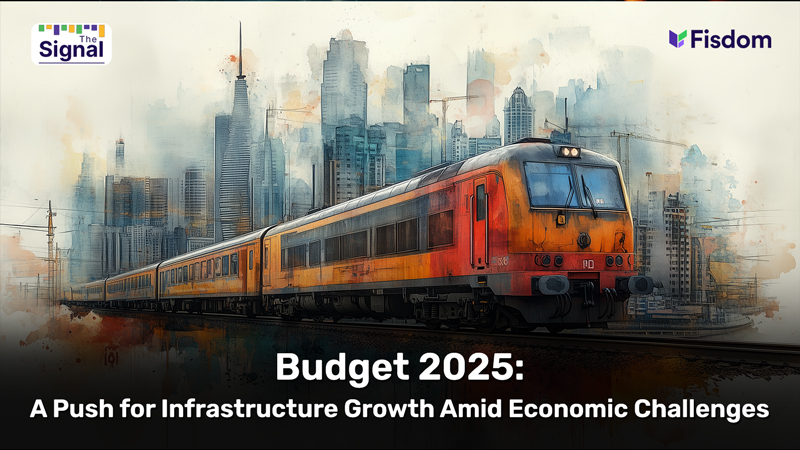
As the Union Budget for FY 2025-26 approaches, all eyes are on the central government’s strategy to stimulate economic growth, particularly through increased capital expenditure (capex). With concerns over a slowdown in economic growth, the upcoming budget is expected to prioritize infrastructure development, with significant allocations for the Ministries of Road Transport and Highways and Railways.
Boost in Capex for Infrastructure Development
The government is likely to increase capex allocation for the Road Transport and Highways Ministry by 10%, underscoring its commitment to infrastructure-led growth. For FY 2024-25, this ministry received a capex of ₹2.72 lakh crore, and projections suggest it may rise further to ₹2.90 lakh crore in FY 2025-26. The National Highways Authority of India (NHAI) has already prepaid ₹56,000 crore in loans for FY 2024-25, lowering its debt to ₹2.76 lakh crore, a trend expected to continue in FY 2025-26.
The government’s focus remains on critical infrastructure projects, with an ambitious target of constructing 12,000 to 13,000 kilometers of national highways in FY 2025-26. This includes access-controlled highways and expressways, while maintenance of the existing road network will also be prioritized. Notably, highway construction has surged by 60% since 2014, with daily construction targets set to exceed 40 kilometers in the upcoming fiscal year.
Railways: A Strategic Focus
The Indian Railways is also expected to see a modest increase in capex, from ₹2.52 lakh crore in FY 2024-25 to ₹2.75 lakh crore in FY 2025-26. Key priorities will include capacity augmentation, electrification, and safety enhancements, with a focus on modernizing rolling stock, such as Vande Bharat trains. However, new project investments will be staggered to ease fiscal pressure.
Public-Private Partnership (PPP) Model Gains Traction
The government aims to attract private investments through the Build-Operate-Transfer (BOT) model for highway projects, with 20-25% of project awards expected under this framework in FY 2025-26. This approach seeks to reduce direct government expenditure while encouraging private-sector participation. Experts have urged the Railways to replicate the success of PPP models seen in the highway sector to boost efficiency and reduce fiscal burdens.
Challenges and Concerns
Despite the government’s infrastructure push, there are concerns about the slowdown in economic growth and public spending. Economists attribute the dip in capex during FY 2024-25 to the General Elections and increased social spending. The delayed final budget for FY 2024-25 also contributed to a year-on-year fall in cumulative public capex since May. Balancing subsidies to address rural distress with capex to drive economic growth remains a significant challenge for the government.
The government met only 37% of its capex target by September 2024, compared to 56% for subsidies. This highlights the pressing need for the government to return to higher capex levels in FY 2025-26 to spur growth and restore economic momentum.
The Correlation Between Capex and Growth
Historically, there has been a strong correlation between government capex and economic growth. The post-Covid recovery period demonstrated the importance of robust infrastructure spending in reviving the economy. With the upcoming budget, the government is expected to prioritize sectors such as roads, railways, airports, defense, and affordable housing. Additionally, supporting private capex in core industries like cement, steel, oil & gas, and power will be crucial to sustaining long-term growth.
Outlook for Economic Growth
Economists and analysts agree that a synchronized push in public and private capex could set the stage for another phase of booming economic growth. Infrastructure investments not only drive immediate economic activity but also lay the foundation for sustained development by improving connectivity, reducing costs, and enhancing productivity.
The government’s strategy of leveraging private sector participation while maintaining a strong focus on critical infrastructure projects is a step in the right direction. If implemented effectively, these initiatives could bolster investor confidence and support India’s journey toward becoming a $5 trillion economy.
In conclusion, Budget 2025 is poised to prioritize infrastructure-led growth, balancing fiscal discipline with the need for increased capex. While challenges remain, the government’s renewed focus on infrastructure, coupled with private sector participation, could pave the way for a robust and resilient economy.
Market this week
| 06th Jan 2025 (Open) | 10th Jan 2025 (Close) | %Change | |
| Nifty 50 | ₹ 24,046 | ₹ 23,432 | -2.6% |
| Sensex | ₹ 79,282 | ₹ 77,379 | -2.4% |
Source: BSE and NSE
- The Indian market ended its two-week winning streak, recording its biggest weekly fall in two months amid broad-based selling, except in the IT sector.
- Persistent FII selling, mixed global markets, uncertainty around US Federal Reserve’s rate plans, and rupee depreciation weighed on sentiment.
- FIIs remained net sellers, offloading equities worth ₹16,854.25 crore during the week, while DIIs extended support, buying equities worth ₹21,682.76 crore.
- Sector-wise performance was weak, with the BSE Power index shedding nearly 9%, BSE Realty falling over 7%, BSE PSU down 7%, and both BSE Capital Goods and Metal indices declining 5% each.
- The BSE Information Technology index was the only sector to close in the green, gaining 1% for the week..
Weekly Leaderboard
| NSE Top Gainers | NSE Top Losers | ||||
| Stock | Change (%) | Stock | Change (%) | ||
| TCS | ▲ | 4.04 % | Shriram Finance | ▼ | (82.55) % |
| Tata Consumer | ▲ | 3.55 % | Trent Ltd | ▼ | (9.90) % |
| HCL Technologies | ▲ | 2.49 % | NTPC | ▼ | (9.30) % |
| Britannia Ind | ▲ | 2.17 % | Tata Steel | ▼ | (7.90) % |
| SBI Life Insurance | ▲ | 2.11 % | Ultratech Cement | ▼ | (7.81) % |
Source: BSE
Stocks that made the news this week:
- Information technology stocks shined amid a sluggish market, driven by Tata Consultancy Services’ (TCS) strong quarterly earnings and positive demand outlook. TCS surged 6%, while other major IT names like Infosys, HCLTech, Wipro, and Tech Mahindra rose between 2-4%. Investors were keen on TCS’ earnings, which set the tone for the sector by signaling early signs of demand revival and robust deal wins. The management projected a stronger performance in CY25 and FY26, which further boosted investor sentiment, placing the IT majors atop the list of Nifty 50 gainers.
- Adani Wilmar shares extended their losing streak, plunging 9.5% to ₹292 on January 10, as promoter Adani Commodities commenced a two-day offer-for-sale (OFS) for non-retail investors. Retail investors can participate in the sale starting January 13. The OFS, priced at ₹275 per share (a 6% discount), involves selling up to 17 crore shares (13.5% of the company’s equity) with an option to sell an additional 8.4 crore shares. The move comes after Adani Enterprises announced plans to exit its joint venture stake in Adani Wilmar, aiming to meet minimum public shareholding norms.
- IREDA shares declined over 3% in January 10 trade due to deteriorating asset quality in the December quarter. Despite posting a 27% YoY rise in net profit to ₹425.37 crore, driven by higher revenues, the Gross Non-Performing Assets (GNPA) ratio increased to 2.68% from 2.19% in the previous quarter, while the Net NPA rose to 1.50% from 1.04%. The stock hit a low of ₹208.42 on the NSE before recovering slightly to ₹211.48, down 2.13% in late morning trade, amid broader market pressure from foreign fund outflows.














